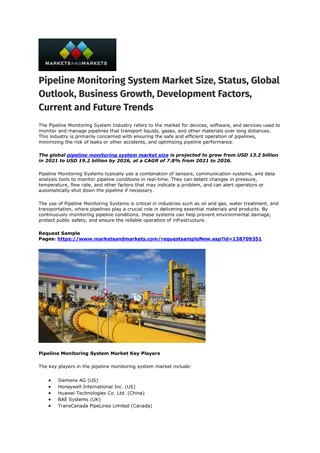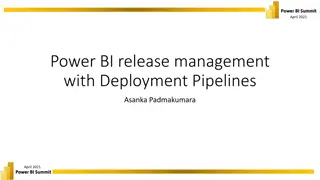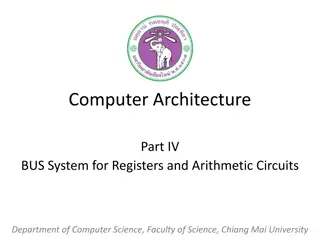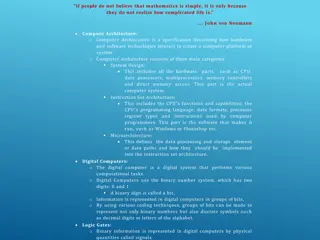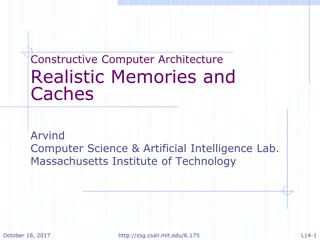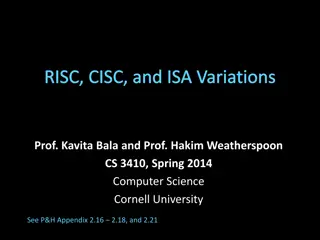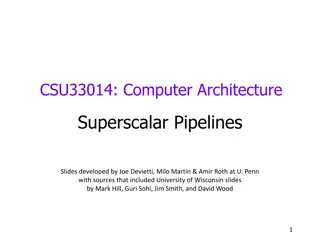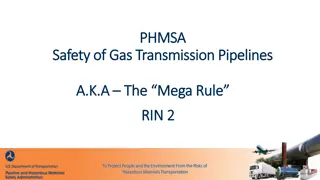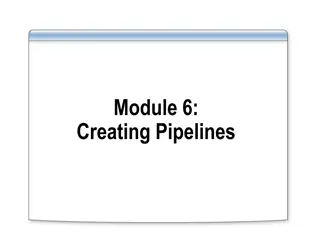Understanding Pipelines in Computer Architecture
Explore the concepts of in-order and out-of-order pipelines, along with the basics of branch prediction. Learn about the challenges and solutions related to data hazards, control hazards, and performance equations in computer architecture. Discover how to optimize pipeline efficiency for faster computing processes.
Download Presentation

Please find below an Image/Link to download the presentation.
The content on the website is provided AS IS for your information and personal use only. It may not be sold, licensed, or shared on other websites without obtaining consent from the author. Download presentation by click this link. If you encounter any issues during the download, it is possible that the publisher has removed the file from their server.
E N D
Presentation Transcript
OOO Pipelines Smruti R. Sarangi
Contents In-order Pipelines Out-of-order Pipelines: Motivation Out-of-order Pipelines: Basics Branch Prediction
Pipelines What do we know up till now: In-order Pipelines Instructions enter the pipeline in program order Register Writeback Inst. Fetch Operand Fetch Memory Access Execute 5-Stage Pipeline
Problems with Inorder Pipelines Register Writeback Inst. Fetch Operand Fetch Memory Access Execute Hazards Structural Hazards Two instructions vie for the same resource (NOT possible in simple 5 stage pipelines) Data Hazards Producer instruction is not ready when the consumer needs the data Control Hazards Instructions are fetched from the wrong path of the branch
Data Hazards in In-order Pipelines Register Writeback Instruction Fetch Operand Fetch Memory Access Execute add r5, r4, 1 ld r4, 4[r0] Need data now Earliest it can be generated Cycle N Cycle N+1 Hazard clock
Solution: Stall the Pipeline Register Writeback Instruction Fetch Operand Fetch Memory Access Execute ld r4, 4[r0] add r5, r4, 1 ld r4, 4[r0] Need data now Here is the data Cycle N Cycle N+1 Cycle N+2 clock
Control Hazards Register Writeback Inst. Fetch Operand Fetch Memory Access Execute beq .label add r1, r2, r3 sub r5, r6, r7 beq .label Cancel these instructions We know the status of the branch now Two instruction slots are wasted
Contents In-order Pipelines Out-of-order Pipelines: Motivation Out-of-order Pipelines: Basics Branch Prediction
Performance Equation Is Computer A faster that computer B Wrong Answers: More is the clock speed, faster is the computer More is the RAM, faster is the computer What does it mean for computer A to be faster than computer B Short Answer: NOTHING Performance is always with respect to a program. You can say that a certain program runs faster on computer A as compared to computer B.
Performance Equation - II #???????? #??????? = #???????? = = ??? ???? *#????? #?????? * #?????? #??????? #????? ??? ???? #?????/??????? #????? (assume just 1 program) Let us loosely refer to the reciprocal of the time per program as the performance
So, what does performance depend on #instructions in the program Depends on the compiler Frequency Depends on the technology and the architecture IPC Depends on the architecture, and the compiler
How to improve performance? There are 3 factors: IPC, instructions, and frequency #instructions is dependent on the compiler not on the architecture Let us look at IPC and frequency IPC What is the IPC of an in-order pipeline? 1 if there are no stalls, otherwise < 1
What about frequency? What is frequency dependent on Frequency = 1 / clock period Clock Period: 1 pipeline stage is expected to take 1 clock cycle Clock period = maximum latency of the pipeline stages How to reduce the clock period Make each stage of the pipeline smaller by increasing the number of pipeline stages Use faster transistors
Limits to Increasing Frequency Assume that we have the fastest possible transistors Can we increase the frequency to 100 GHz Reasons
Limits to increasing frequency - II What does it mean to have a very high frequency? Before answering keep these facts in mind: P power f frequency Thumb Rule ? ?3 1 P power T Temperature Thermo- dynamics 2 T ? We need to increase the number of pipeline stages more hazards, more forwarding paths 3
How many pipeline stages can we have? Logic Logic Latch Latch Latch Even more stages More stages Few stages We are limited by the latch delay Even with an infinite number of stages, the minimum clock period will be equal to the latch delay
Pipeline Stages vs IPC CPI = 1/ IPC CPI = CPIideal + stall_rate * stall_penalty The stall rate will remain more or less constant per instruction with the number of pipeline stages The stall penalty (in terms of cycles) will however increase This will lead to a loss in IPC
Summary: Why we cannot increase frequency? Power Temperature Effect of the Latch Delay Stall penalties will increase
Since we cannot increase frequency Increase IPC
Increase IPC Issue more instructions per cycle 2, 4, or 8 instructions Make it a superscalar processor A processor that can execute multiple instructions per cycle
In-order Superscalar Processor Have multiple pipelines. Register Writeback Inst. Fetch Operand Fetch Memory Access Instruction i Execute Register Writeback Inst. Fetch Operand Fetch Memory Access Instruction i+1 Execute Register Writeback Inst. Fetch Operand Fetch Memory Access Instruction i+2 Execute
In-order Superscalar Processor - II There can be dependences between instructions Have O(n2) forwarding paths for a n-issue processor Complicated logic for detecting dependences, hazards, and forwarding Still might not be enough ... To get the peak IPC (= n) in an n-issue pipeline, we need to ensure that there are no stalls There will be no stalls if there are no taken branches, and no data dependences between instructions. Programs typically do not have such long sequences of instructions without dependences
What to do ... Don t follow program order Consider mov r1, 1 add r3, r1, r2 add r4, r3, r2 mov r5, 1 add r6, r5, 1 add r8, r7, r6 Too many dependences
Execute out of order Execute on a 2-issue OOO processor mov r1, 1 add r3, r1, r2 add r4, r3, r2 mov r5, 1 add r6, r5, 1 add r8, r7, r6
Execution on a 2-issue OOO Processor issue slot 1 issue slot 2 cycle 1 cycle 2 cycle 3 mov r1, 1 add r3, r1, r2 add r4, r3, r2 mov r5, 1 add r6, r5, 1 add r8, r7, r6
Basic OOO idea Create a pool of instructions Find instructions that are mutually independent and have all their operands ready Execute them out of order
Contents In-order Pipelines Out-of-order Pipelines: Motivation Out-of-order Pipelines: Basics Branch Prediction
Revisit the Example Pool of Instructions mov r1, 1 add r3, r1, r2 add r4, r3, r2 mov r5, 1 add r8, r7, r6 add r6, r5, 1 Issue ready and mutually independent instructions
Pool of Instructions Needs to be large enough such that the requisite number of mutually independent instructions can be found Typical instruction pool sizes: 64 to 128 How do we create a large pool of instructions in a program with branches? We need to be sure that the instructions are on the correct path for (i = 1; i < m; i++) { for (j = 1; j < i; j ++ ) { if (j %2 == 0) continue; .... } }
Problems with creating an Instruction Pool Typically 1 in 5 instructions is a branch Predict the direction of the branches, and their targets
Dependences between Instructions Program Order Dependence mov r1, 1 mov r2, 2 One instruction appears after the other in program order The program order is the order of instructions that is perceived by a single cycle in-order processor executing the program.
Data Dependences RAW Read after Write Dependence (True dependence) mov r1, 1 add r3, r1, r2 It is a producer-consumer dependence. The earlier instruction produces a value, and the later instruction reads it.
Data Dependences - II WAW Write after Write Dependence (Output dependence) mov r1, 1 add r1, r4, r2 Two instructions write to the same location The later instruction needs to take effect after the former
Data Dependences - III WAR Write after Read Dependence (Anti dependence) add r1, r2, r3 add r2, r5, r6 Earlier instruction reads, later instruction writes The later instruction needs to execute after the earlier instruction has read its values
Control Dependences beq .label ..... .label add r1, r2, r3 The add instruction is control dependent on the branch(beq) instruction If the branch is taken then only the add instruction will execute, not otherwise
Basic Results In-order processors respect the program order dependences. Thus, they automatically respect all data and control dependences. OOO processors respect only data and control dependences.
Can output and anti dependences be removed? add r1, r2, r3 add r2, r5, r6 mov r1, 1 add r1, r4, r2 Don t you think that these dependences are there because we have a finite number of registers. What if we had an infinite number of registers?
Solution: Infinite number of registers mov r1, 1 add r1, r2, r3 add r4, r1, 1 mov r2, 5 add r6, r2, r8 mov r1, 8 add r9, r1, r2 mov v1, 1 add v11, v2, v3 add v4, v11, 1 mov v12, 5 add v6, v12, v8 mov v21, 8 add v9, v21, v12 Code with architectural registers Code with virtual registers
Renaming Program with virtual registers Program with real (architectural) registers RAW dependences RAW dependences WAR dependences WAW dependences Higher instruction level parallelism (ILP)
Where are we now ... Pool of Instructions Fetch + Decode + Rename + Reg. Read Issue Memory Execution Units Write back results
Issue with writeback Register File Update State Instructions Processor Memory To an outsider should it matter if the processor is in-order or OOO Answer is NO
Assume that there is an exception or interrupt Divide by 0 mov r4, 10 mov r2, 0 div r3, r1, r2 sub r4, r4, 1 Divide by zero handler Languages like Java have dedicated functions that are called if there is a divide-by-zero in the code. The question is: Would the sub instruction have executed when we enter the exception handler
Precise Exceptions sub inst. Exception handler by 0 Regular Instructions Assume that the exception handler decides to do nothing and return back After this the sub instruction should be executed This is exactly what will happen in an in-order processor In an OOO processor there is a possibility that the sub inst. can execute out of order
Precise Exceptions - II Correct sub inst. Exception handler by 0 Regular Instructions Wrong sub inst. Exception handler by 0 Regular Instructions To an external observer The execution should always be correct Even in the presence of interrupts and exceptions
Precise Exceptions - III We thus need precise exceptions Assume that the dynamic instructions in a program (ordered in program order) are: ins1, ins2, ins3 ... insn Assume that the processor starts the exception/interrupt handler after it has just finished writing the results of instruction: insk Then instructions: ins1 ... insk should have executed completely and written their results to the memory/register file AND, insk+1 onwards should appear to not have started their execution at all Such an exception or interrupt is precise
Precise Exceptions in OOO Processor Now, in an OOO processor how can exceptions be precise? We need a mechanism to ensure that instructions appear to execute in order to not an external observer Anything can happen inside the processor But an external observer should not be able to make out if the processor is in- order or OOO
Contents In-order Pipelines Out-of-order Pipelines: Motivation Out-of-order Pipelines: Basics Branch Prediction
Timing Fetch ith instruction Fetch (i+1)th instruction Predict (i+1)th instruction Fetch (i+2)th instruction Predict (i+2)th instruction Predict (i+3)th instruction There is no time to look at an instruction
Branch Prediction There are several things to predict: 1. Predict if an instruction is a branch or not 2. If it is a branch, predict its outcome 3. If the branch is taken, predict its target General structure of a predictor Program Counter (PC) Prediction Predictor
Is an instruction a branch or not? Insights Given a PC, the status of the instruction (branch or not) does not change Can we use this information? Approach The last time that we had seen a branch remember its PC Next time we see a PC, check if we have seen it before Also remember the type of the branch: Unconditional Conditional Function call Return


![❤Book⚡[PDF]✔ The Apollo Guidance Computer: Architecture and Operation (Springer](/thumb/21611/book-pdf-the-apollo-guidance-computer-architecture-and-operation-springer.jpg)



